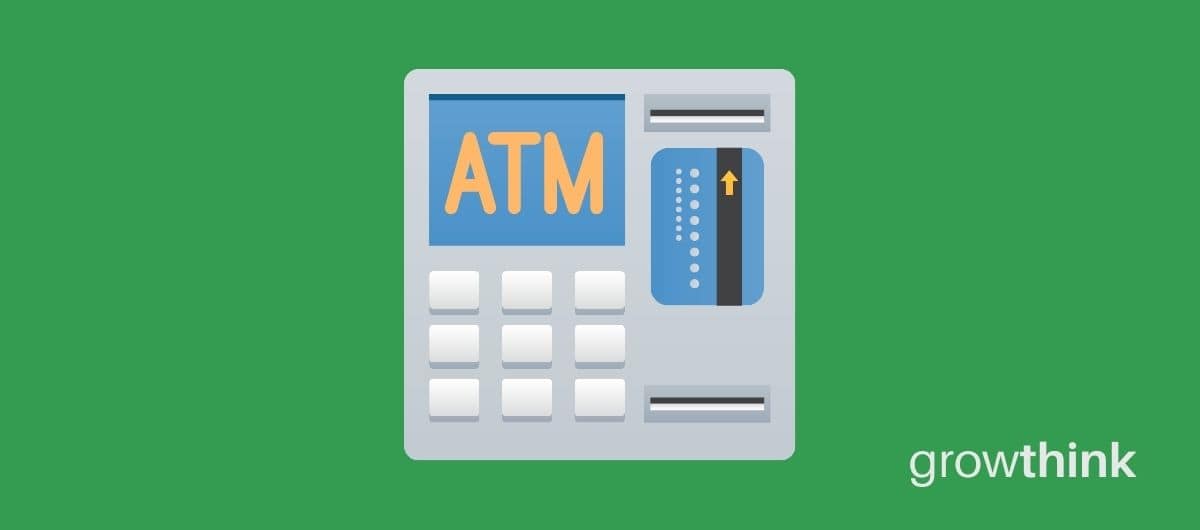
Starting an ATM business can be very profitable. With proper planning, execution and hard work, you can enjoy great success. Below you will learn the keys to launching a successful ATM business.
Importantly, a critical step in starting your own ATM business is to complete your business plan. To help you out, you should download Growthink’s Ultimate Business Plan Template here.
14 Steps To Start an ATM Business:
- Choose the Name for Your ATM Business
- Develop Your ATM Business Plan
- Choose the Legal Structure for Your ATM Business
- Secure Startup Funding for Your ATM Business (If Needed)
- Secure a Location for Your ATM Machines
- Register Your ATM Business with the IRS
- Open a Business Bank Account
- Get a Business Credit Card
- Get the Required Business Licenses and Permits
- Get Business Insurance for Your ATM Business
- Buy or Lease the Right ATM Business Equipment
- Develop Your ATM Business Marketing Materials
- Purchase and Setup the Software Needed to Run Your ATM Business
- Open for Business
1. Choose the Name for Your ATM Business
The first step to start an ATM business is to choose your business name.
This is a very important choice since your company name is your brand and will last for the lifetime of your business. Ideally, you choose a name that is meaningful and memorable. Here are some tips for choosing a name for your own ATM business:
- Make sure the name is available. Check your desired name against trademark databases and your state’s list of registered business names to see if it’s available. Also check to see if a suitable domain name is available.
- Keep it simple. The best names are usually ones that are easy to remember, pronounce and spell.
- Think about marketing. Come up with a name that reflects the desired brand and/or focus of your ATM business.
2. Develop Your ATM Business Plan
One of the most important steps in starting an ATM business is to develop your ATM business plan. The process of creating your plan ensures that you fully understand your market and your business strategy. The plan also provides you with a roadmap to follow and if needed, to present to funding sources to raise money for your business.
Your business plan should include the following sections:
- Executive Summary – this section should summarize your entire business plan so readers can quickly understand the key details of your ATM business.
- Company Overview – this section tells the reader about the history of your ATM machine business and what type of ATM business you operate. For example, are you an independent ATM deployer, a financial institution, or an independent sales organization? Independent ATM deployers are companies that operate and own ATM machines. Financial institutions are traditional owners of ATMs, and they can be either commercial banks or credit unions. Independent sales organizations are companies that market, install, and service ATMs on behalf of financial institutions or independent ATM deployers.
- Industry Analysis – here you will document key information about the ATM industry. Conduct market research and document how big the ATM industry is and what trends are affecting it.
- Customer Analysis – in this section, you will document who your ideal or target market are and their demographics. For example, how old are they? Where do they live? What do they find important when purchasing products and/or services like the ones you will offer?
- Competitive Analysis – here you will document the key direct and indirect competitors you will face and how you will build competitive advantage.
- Marketing Plan – your marketing plan should address the 4Ps: Product, Price, Promotions and Place.
- Product: Determine and document what products/services you will offer
- Prices: Document the prices of your products/services
- Place: Where will your ATM machines be located and how will that location help you increase sales?
- Promotions: What promotional methods will you use to attract customers to your ATM machines? For example, you might decide to use pay-per-click advertising, public relations, search engine optimization and/or social media marketing.
- Operations Plan – here you will determine the key processes you will need to run your day-to-day operations. You will also determine your staffing needs. Finally, in this section of your plan, you will create a projected growth timeline showing the milestones you hope to achieve in the coming years.
- Management Team – this section details the background of your company’s management team.
- Financial Plan – finally, the financial plan answers questions including the following:
- What startup costs will you incur?
- How will your ATM business make money?
- What are your projected ATM sales and expenses for the next five years?
- Do you need to raise funding to launch your business
Finish Your Business Plan Today!
If you’d like to quickly and easily complete your business plan, download Growthink’s Ultimate Business Plan Template and complete your plan and financial model in hours.
3. Choose the Legal Structure for Your ATM Business
Next you need to choose a legal business structure for your ATM business and register it and your business name with the Secretary of State in each state where you operate your business.
Below are the five most common legal structures:
1) Sole proprietorship
A sole proprietorship is a business entity in which the owner of the ATM business and the business are the same legal person. The owner of a sole proprietorship is responsible for all debts and obligations of the business. There are no formalities required to establish a sole proprietorship, and it is easy to set up and operate. The main advantage of a sole proprietorship is that it is simple and inexpensive to establish. The main disadvantage is that the owner is liable for all debts and obligations of the business.
2) Partnerships
A partnership is a legal structure that is popular among small businesses. It is an agreement between two or more people who want to start an ATM business together. The partners share in the profits and losses of the business.
The advantages of a partnership are that it is easy to set up, and the partners share in the profits and losses of the business. The disadvantages of a partnership are that the partners are jointly liable for the debts of the business, and disagreements between partners can be difficult to resolve.
3) Limited Liability Company (LLC)
A limited liability company, or LLC, is a type of business entity that provides limited liability to its owners. This means that the owners of an LLC are not personally responsible for the debts and liabilities of the business. The advantages of an LLC for an ATM business include flexibility in management, pass-through taxation (avoids double taxation as explained below), and limited personal liability. The disadvantages of an LLC include lack of availability in some states and self-employment taxes.
4) C Corporation
A C Corporation is a business entity that is separate from its owners. It has its own tax ID and can have shareholders. The main advantage of a C Corporation for an ATM business is that it offers limited liability to its owners. This means that the owners are not personally responsible for the debts and liabilities of the business. The disadvantage is that C Corporations are subject to double taxation. This means that the corporation pays taxes on its profits, and the shareholders also pay taxes on their dividends.
5) S Corporation
An S Corporation is a type of corporation that provides its owners with limited liability protection and allows them to pass their business income through to their personal income tax returns, thus avoiding double taxation. There are several limitations on S Corporations including the number of shareholders they can have among others.
Once you register your business, your state will send you your official “Articles of Incorporation.” You will need this among other documentation when establishing your banking account (see below). We recommend that you consult an attorney in determining which legal structure is best suited for your company.
Incorporate Your Business at the Guaranteed Lowest Price
We are proud to have partnered with Business Rocket to help you incorporate your business at the lowest price, guaranteed.
Not only does BusinessRocket have a 4.9 out of 5 rating on TrustPilot (with over 1,000 reviews) because of their amazing quality…but they also guarantee the most affordable incorporation packages and the fastest processing time in the industry.
Incorporate with BusinessRocket at the guaranteed lowest price now.
4. Secure Startup Funding for Your ATM Business (If Needed)
In developing your ATM business plan, you might have determined that you need to raise funding to launch your business.
If so, the main sources of funding for an ATM business to consider are personal savings, family and friends, credit card financing, bank loans, crowdfunding and angel investors. Angel investors are individuals who provide capital to early-stage businesses. Angel investors typically will invest in an ATM business that they believe has high potential for growth.
5. Secure a Location for Your ATM Machines
There are a few things to consider when looking for a location for your ATM business. First, you’ll want to find a spot that is convenient for your customers. Make sure the office space is easily accessible and has ample parking. You’ll also want to consider the cost of doing business in the area. Ideally, you’ll want to find a spot where you can charge a reasonable fee for your services.
Some common ATM locations are convenience stores, retail stores, bars, gas stations, supermarkets, and pharmacies.
6. Register Your ATM Business with the IRS
Next, you need to register your business with the Internal Revenue Service (IRS) which will result in the IRS issuing you an Employer Identification Number (EIN).
Most banks will require you to have an EIN in order to open up an account. In addition, in order to hire employees, you will need an EIN since that is how the IRS tracks your payroll tax payments.
Note that if you are a sole proprietor without employees, you generally do not need to get an EIN. Rather, you would use your social security number (instead of your EIN) as your taxpayer identification number.
7. Open a Business Bank Account
It is important to establish a bank account in your ATM business’ name. This process is fairly simple and involves the following steps:
- Identify and contact the bank you want to use
- Gather and present the required documents (generally include your company’s Articles of Incorporation, driver’s license or passport, and proof of address)
- Complete the bank’s application form and provide all relevant information
- Meet with a banker to discuss your business needs and establish a relationship with them
8. Get a Business Credit Card
You should get a business credit card for your ATM business to help you separate personal and business expenses.
You can either apply for a business credit card through your bank or apply for one through a credit card company.
When you’re applying for a business credit card, you’ll need to provide some information about your business. This includes the name of your business, the address of your business, and the type of business you’re running. You’ll also need to provide some information about yourself, including your name, Social Security number, and date of birth.
Once you’ve been approved for a business credit card, you’ll be able to use it to make purchases for your business. You can also use it to build your credit history which could be very important in securing loans and getting credit lines for your business in the future.
9. Get the Required Business Licenses and Permits
To operate an ATM business you will need a permit. The location of the ATM must be in compliance with your local permit requirements, which also means that you may not violate any zoning codes. The city will inspect your location and verify that it is in compliance with zoning codes and their ordinances.
Each state has its own license and permit requirements. You may also will need:
- A Class C liquor license if you plan to install an ATM inside a place of business selling alcoholic beverages.
- A sign permit from the Department of Transportation (DOT) if the ATM is to be installed on a highway, parking area, or pedestrian mall.
- A shoreline substantial development permit from the Department of Environmental Quality (DEQ).
Depending on the type of ATM business you launch, you will have to obtain the necessary state, county and/or city licenses.
10. Get Business Insurance for Your ATM Business
The type of insurance you need to operate an ATM business depends on the risks associated with your particular business. For example, if you are located in a high-crime area, you may need to purchase liability insurance to protect yourself from potential lawsuits. If you are renting space to operate your ATM business, you will need to take the location of the ATM into consideration. If part of your policy includes protecting against damage or theft at a given location, make sure that this is clearly stated in the insurance contract.
Other business insurance policies that you should consider for your ATM business include:
- General liability insurance: This covers accidents and injuries that occur on your property. It also covers damages caused by your employees or products.
- Workers’ compensation insurance: If you have employees, this type of policy works with your general liability policy to protect against workplace injuries and accidents. It also covers medical expenses and lost wages.
Find an insurance agent, tell them about your business and its needs, and they will recommend policies that fit those needs.
Finish Your Business Plan Today!
If you’d like to quickly and easily complete your business plan, download Growthink’s Ultimate Business Plan Template and complete your plan and financial model in hours.
11. Buy or Lease the Right ATM Business Equipment
In order to start an ATM business, you will need the following equipment: an ATM machine or multiple ATM machines, a computer, internet line, phone line, scanner, square reader, debit card processing account, currency notes from different countries, security camera, safe, tools for routine maintenance, and an alarm system.
12. Develop Your ATM Business Marketing Materials
Marketing materials will be required to attract and retain customers to your ATM business.
The key marketing materials you will need are as follows:
- Logo: Spend some time developing a good logo for your ATM business. Your logo will be printed on company stationery, business cards, marketing materials and so forth. The right logo can increase customer trust and awareness of your brand.
- Website: Likewise, a professional ATM business website provides potential customers with information about the products and/or services you offer, your company’s history, and contact information. Importantly, remember that the look and feel of your website will affect how customers perceive you.
- Social Media Accounts: establish social media accounts in your company’s name. Accounts on Facebook, Twitter, LinkedIn and/or other social media networks will help customers and others find and interact with your ATM business.
13. Purchase and Setup the Software Needed to Run Your ATM Business
The software you need to run an ATM business is a point-of-sale (POS) system and a back-office system.
The point-of-sale system is the user interface that the customers interact with. Some common systems used to run an ATM business include Zenith, Wincor Nixdorf and Diebold.
Back-office software records ATM transaction information and provides reports on account balances and transactions. Software such as SunGard ‘s Velocity enables back office functions such as cash management, accounting, and audit trail. The ATMs themselves often run Windows-based software that integrates into the back-office software.
14. Open for Business
You are now ready to open your ATM business. If you followed the steps above, you should be in a great position to build a successful ATM business. Below are answers to frequently asked questions that might further help you.
Finish Your ATM Business Plan in 1 Day!
Don’t you wish there was a faster, easier way to finish your ATM business plan?
With Growthink’s Ultimate Business Plan Template you can finish your plan in just 8 hours or less!
Click here to finish your business plan today.
Additional Resources
ATM Mavericks: www.atmmavericks.com
How to Start an ATM Business FAQs
Is it hard to start an ATM business?
The difficulty of starting an ATM business depends on a variety of factors such as the location of your business and the competition in your area. However, with proper planning and execution, starting an ATM business can be a lucrative and successful venture.
How can I start an ATM business with no experience?
There are a few ways to start an ATM business with no experience. You could start by researching the industry and learning about the different types of ATMs, the best locations for ATMs, and how to manage and operate an ATM business. Alternatively, you could partner with an experienced ATM business owner who can help guide you through the process.
What type of ATM business is most profitable?
The most profitable type of ATM business is full-service. This type of ATM business typically offers cash withdrawals, deposits, and money transfers. A full-service ATM business also typically offers bill payment services and check cashing.
How much does it cost to start an ATM business?
There is no one definitive answer to this question, as the cost of starting an ATM business will vary depending on a number of factors, including the size and location of your business. That said, here are some ballpark estimates to give you an idea:
- Initial equipment costs: $2,000-$10,000
- Monthly processing fees: $25-$50
- Additional costs (such as security, marketing, and signage): Varies depending on your business model
- Monthly fees that you charge your customers: Varies depending on the amount of transactions and monthly fees that you choose to charge, as well as whether or not you choose to offer a fee-free option.
What are the ongoing expenses for an ATM business?
The ongoing expenses for an ATM machine business are typically rent or lease payments for the space where the ATM is located, as well as network accessing fees charged to the business by the financial institution that operates the ATM. These fees can vary based on several factors. In addition to that, there are small incidental and operating costs such as monthly phone service, tolls, and insurance on the ATM machine. These incidental costs depend upon the size and location of the ATM.
How To Invest in an ATM?
Investing in ATMs can be a smart way to earn money. First, you need to buy or lease an ATM machine. Then, find a good place to put it, like a busy store or a mall, where lots of people will use it. Remember, you make money from the fees people pay to use the ATM, so the more people use it, the more money you can make.
How does an ATM business make money?
ATM machines make money by charging transaction fees for their services. This can include a fee to use the ATM, a fee to withdraw cash, or a fee to deposit money.
Is owning an ATM business profitable?
Yes, owning an ATM machine business can be profitable because there is a consistently high demand for ATMs. Not only do people need them for personal transactions, but businesses also rely on ATMs. Additionally, the cost to maintain an ATM machine is relatively low, which can help keep profits high.
Why do ATM businesses fail?
One possible reason is that ATM businesses have high startup costs. In order to be profitable, an ATM business needs to have a large number of machines in a relatively small area. This can be difficult to achieve, especially in rural areas where there are not as many potential customers.
However, not all ATM operators fail because of high startup costs. Many of them actually fail because they don't keep proper records of their customers or provide accurate accounting statements to potential investors. This can lead to the company's untimely demise.
Another possible reason for ATM business failure is that most businesses depend on one dominant company. If this company decides to change its strategy, it may decide to install its own machines.

 Business Plan Template & Guide For Small Businesses
Business Plan Template & Guide For Small Businesses How To Write A Great Business Plan
How To Write A Great Business Plan 100 Business Plan Examples To Use To Create Your Plan
100 Business Plan Examples To Use To Create Your Plan